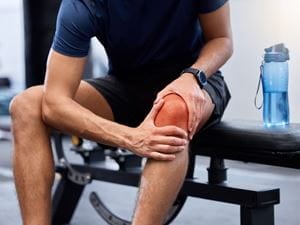
Knee pain, injuries, and general wear and tear on the joints are common occurrences for numerous people and should be considered when choosing your workouts. There are multiple types of common knee injuries. You may be dealing with an issue like tendonitis, an ACL tear, arthritis, a strain and more.
Because of that, what you should and shouldn’t be doing for your knee health may differ based on what you’re dealing with. Still, some kinds of movements aren’t great for any knee injury. As a rule of thumb, for general knee pain, you should avoid most activities or movements that irritate it. If you notice swelling or pain, you’ll want to avoid the exercise that caused the sensation. Here are some activities that aren’t recommended for people with knee problems.
Jumping.
It might go without saying, but if you’re dealing with knee issues, you don’t want to do any workout that involves jumping. High-impact activity can irritate general knee pain, including explosive-based activities, so be wary of jumping rope, jumping jacks, vertical leaping or jump squats. If you’re an avid basketball player or have to do a sport that requires jumping, it would be best to avoid those movements as well.
Running.
Running, which involves running on hard surfaces, is another activity to avoid for people with knee problems. If you have knee issues and you’re out running, be conscious about the surface you run on. If you prefer running outside, find a grassy or dirt area to run on instead of running on concrete. However, remember that running on softer surfaces still impacts your joints, which can be painful.
It’s uncomfortable because running puts a lot of weight on those areas. Instead, try getting on an elliptical or a bike, which are non-impact for the knee joints. It can give good exercise without the impact. The best thing for people with knee problems, specifically for older adults, is walking. It’s a good and challenging workout with benefits like reducing heart disease risk and good for your mental health.
Deep lunges and squats.
Lunges and squats will pull on your knee, making it unsafe to do them at full range. If you’ve had a prior knee injury, you could do three-quarter squats until you can safely go full range. Sissy squats, which require you to be on your toes and lean back with your knees lower on the ground, aren’t a good exercise for those with knee pain. Chair squats can be a good alternative for those looking to do squats but can’t safely do the typical movement. For chair squats, you touch your butt to the top of the chair during your squat instead of going beyond the 90-degree angle, which helps limit how far you’re going down.
Exercises with quick changes.
Movements that require you to pivot or twist can be a real issue for those with bad knees. These movements can cause real problems for people with bad knees. These activities can include football, basketball, martial arts, and dancing. People with knee problems can avoid that twisting and change of direction until they build more stability in their knee and structure. The pivoting and twisting that happens can mess with the trajectory of your knee. If your knee is unstable while exercising, you risk hurting yourself.
Unless you have a compression or knee sleeve that will give you that stability when you’re changing directions or pivoting, you want to be cautious with lateral movements like dancing, lateral shuffles and lateral jumps, avoiding them overall. Explosive or Olympic lifting is another exercise those with knee problems should avoid. Examples include doing barbell squats, snatch lifts, or lifting a barbell over your head. Those types of lifts are explosive movements. Instead, try using a controlled weight machine at the gym that won’t cause a high amount of impact on your joints.
Water-based activities can alleviate pain.
Most people with joint pain usually turn to water movement for exercise, which includes water movements with weights and water aerobics. Additionally, swimming has been found to help reduce joint stiffness and pain in those with osteoarthritis, according to a study published in the Journal of Rheumatology. Swimming reduces the weight you place on your joints, especially on your knees.
You can move and float around feeling looser and less strain of gravity’s impact. Knee sleeves can stabilize the tracking of your knee, helping your body deal with inflammation and impact during a run. Specifically, Hyperice is a functional knee sleeve that uses contrast therapy, so it goes from hot to cold, which helps with blood flow, inflammation, circulation, and different things. Knee straps can also help for walks. They release some pressure on your knee while walking, so if you have arthritis, that would be great. Knee straps can also help if you’re going on a long drive. It’s also essential to wear sneakers with good cushioning.
Think of your body as a whole.
More acute traumas like sprains and strains often come from a limited range of motion or tightness elsewhere. Everything in your body is so connected that if one part is tight and you move it wrong, it will have a domino effect on the rest of your body. It’s essential to look at the joints above and below the impacted joint. How tight are your calf or hip muscles? Could that be contributing to your pain?
In our bodies, nothing works in isolation. You want to ensure you’re stretching different body parts, properly warming up, cooling down, and taking rest days. If the problem is the knee, you can focus on the knee joint, but you should also address weaknesses in your flexibility issues in your hip or tightness in your ankle joints. Those can give you pain in different areas.
You should take your knee or any bodily pain seriously. If you have knee issues, you should see an orthopedic surgeon to address what’s happening and get advice for your specific problem. It’s essential not to neglect your health. Pain is typically a sign of a more significant issue. Some people believe pain is terrible, but it can be good. It tells us we’re doing something wrong for our bodies.

